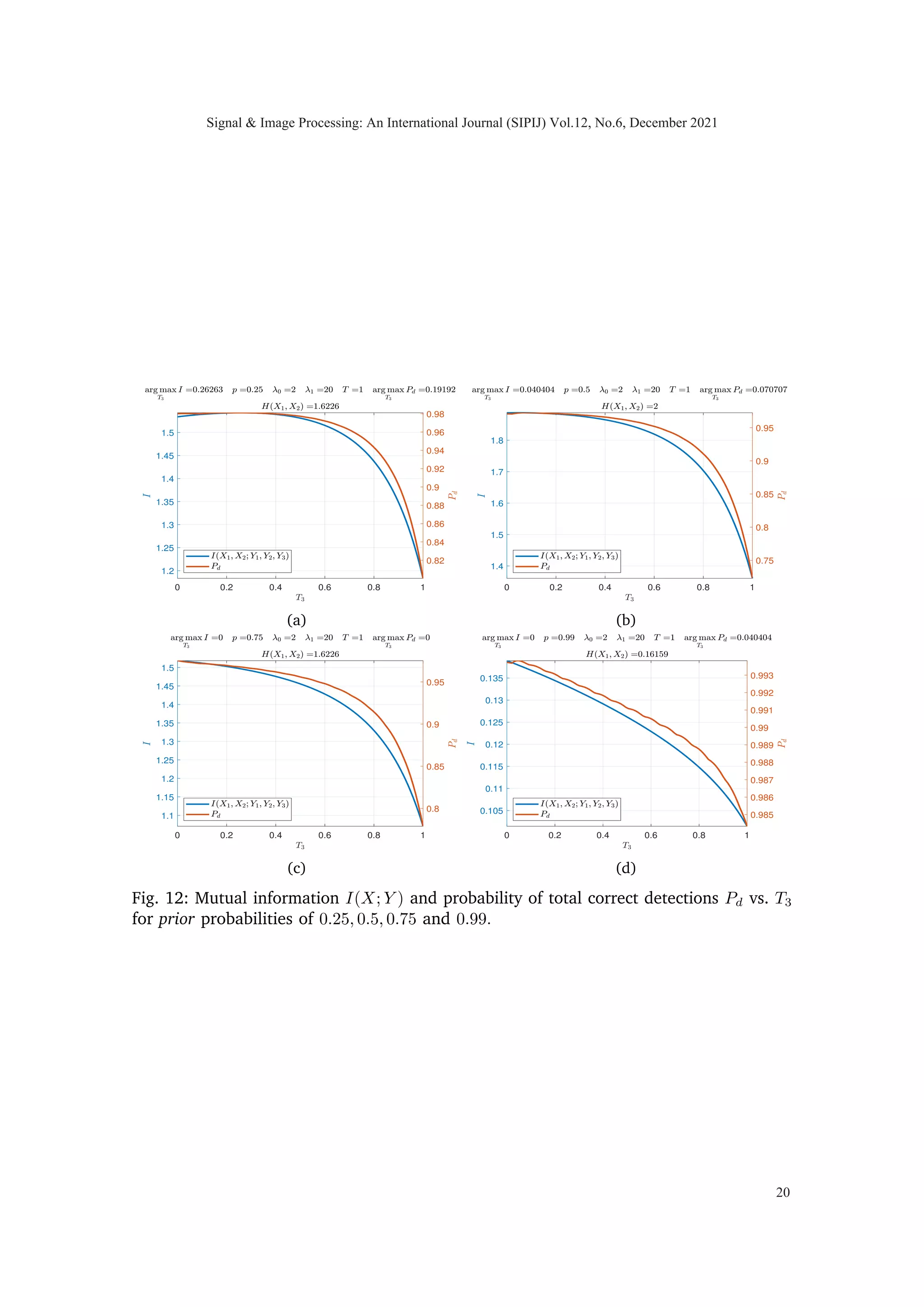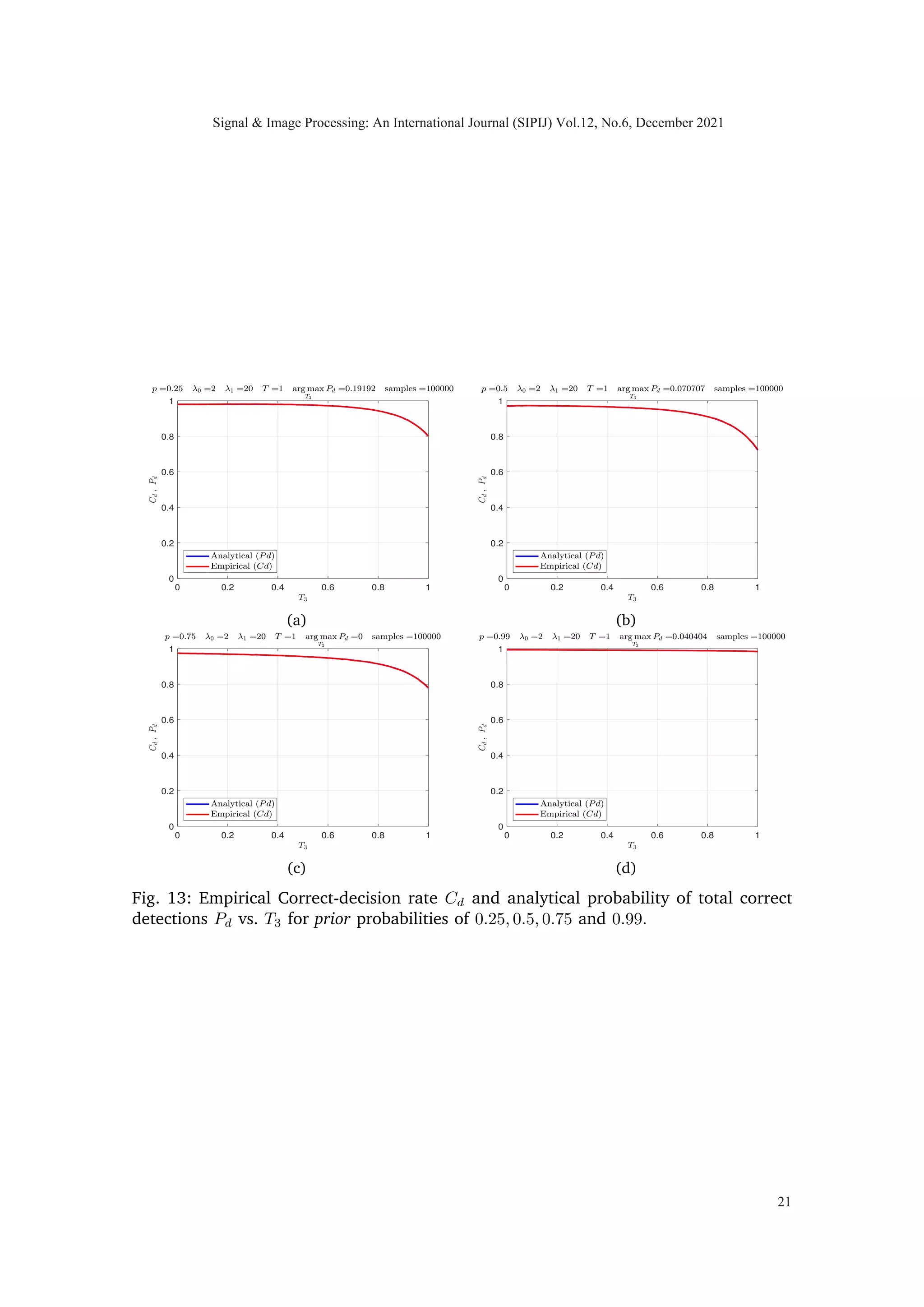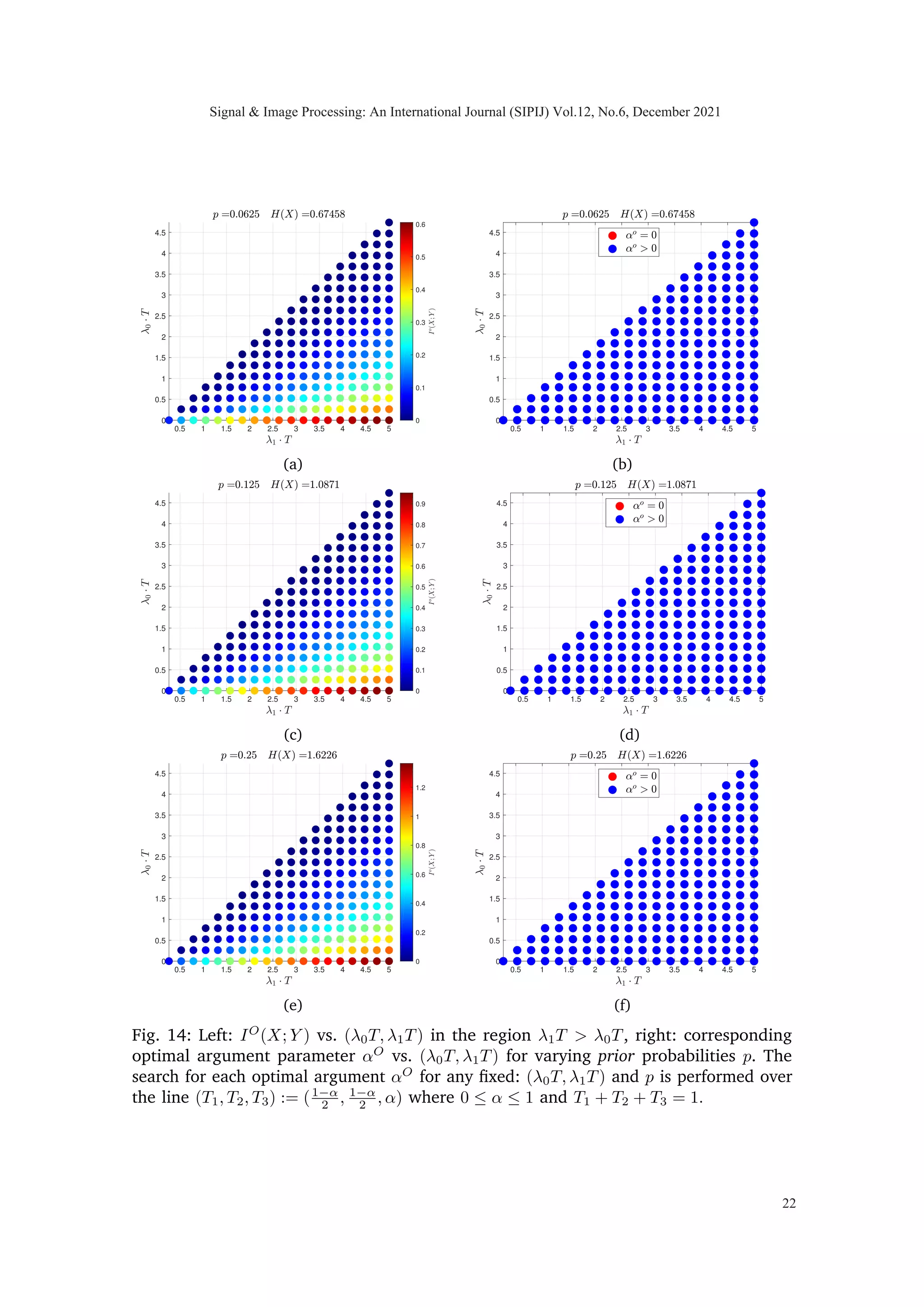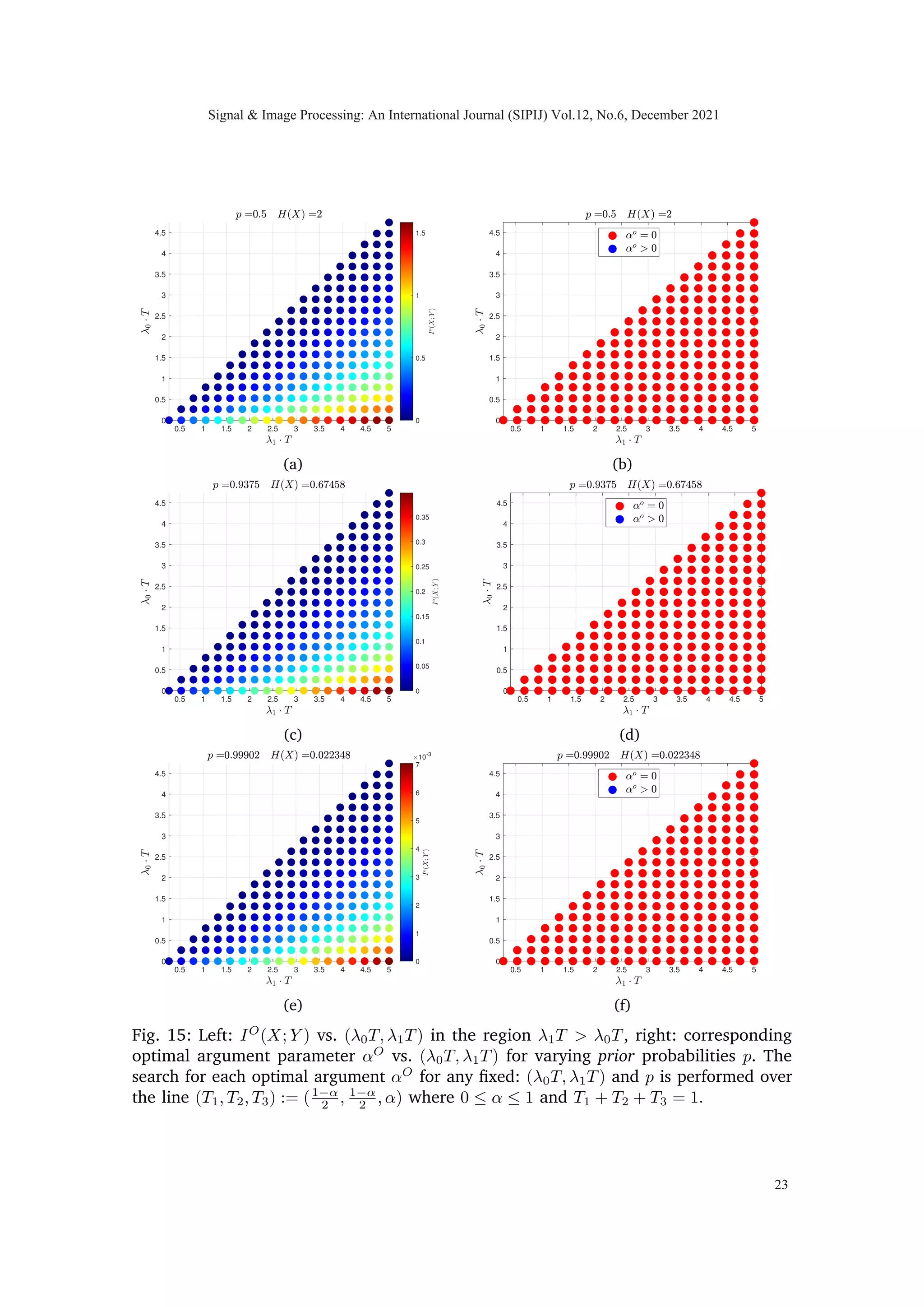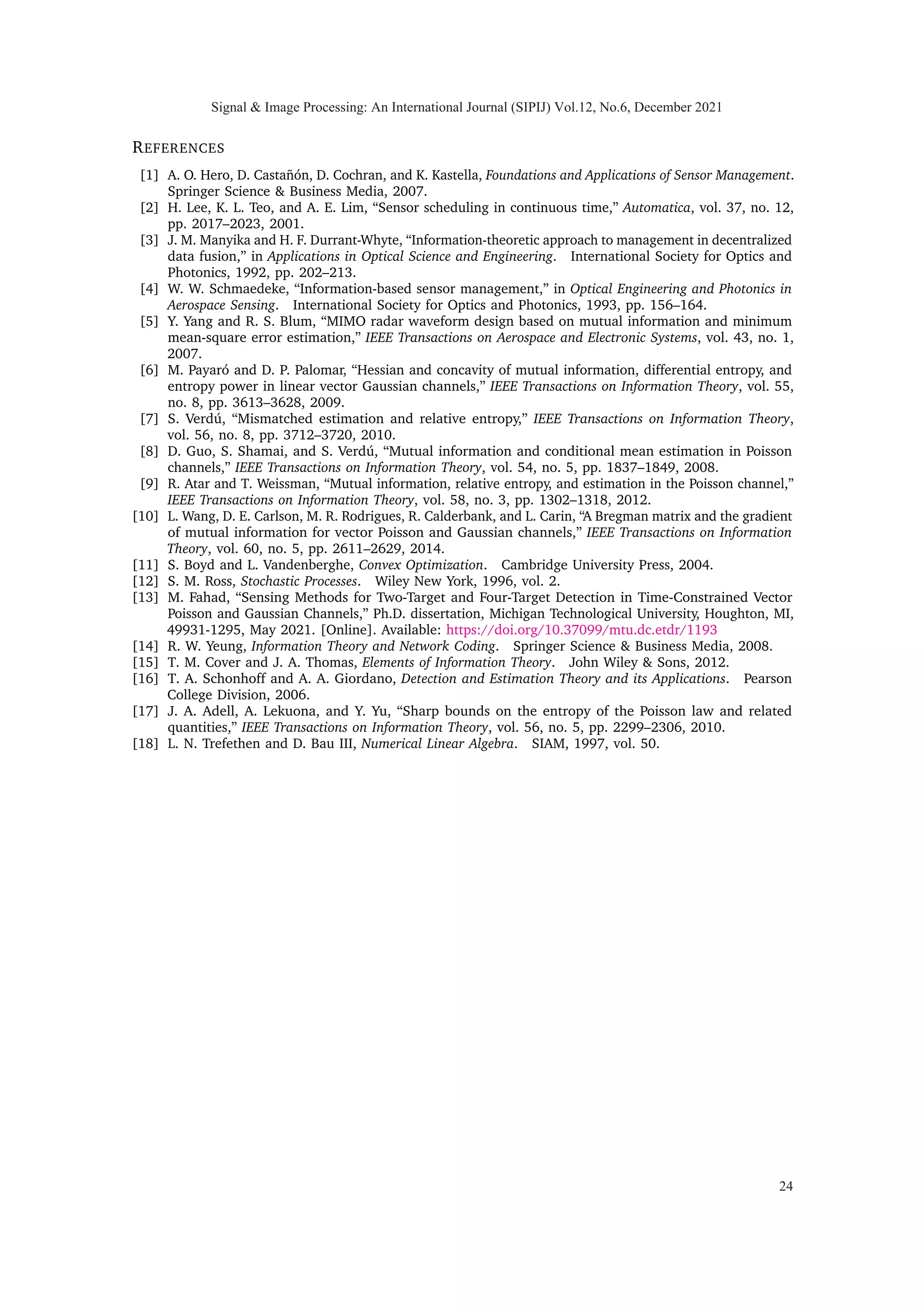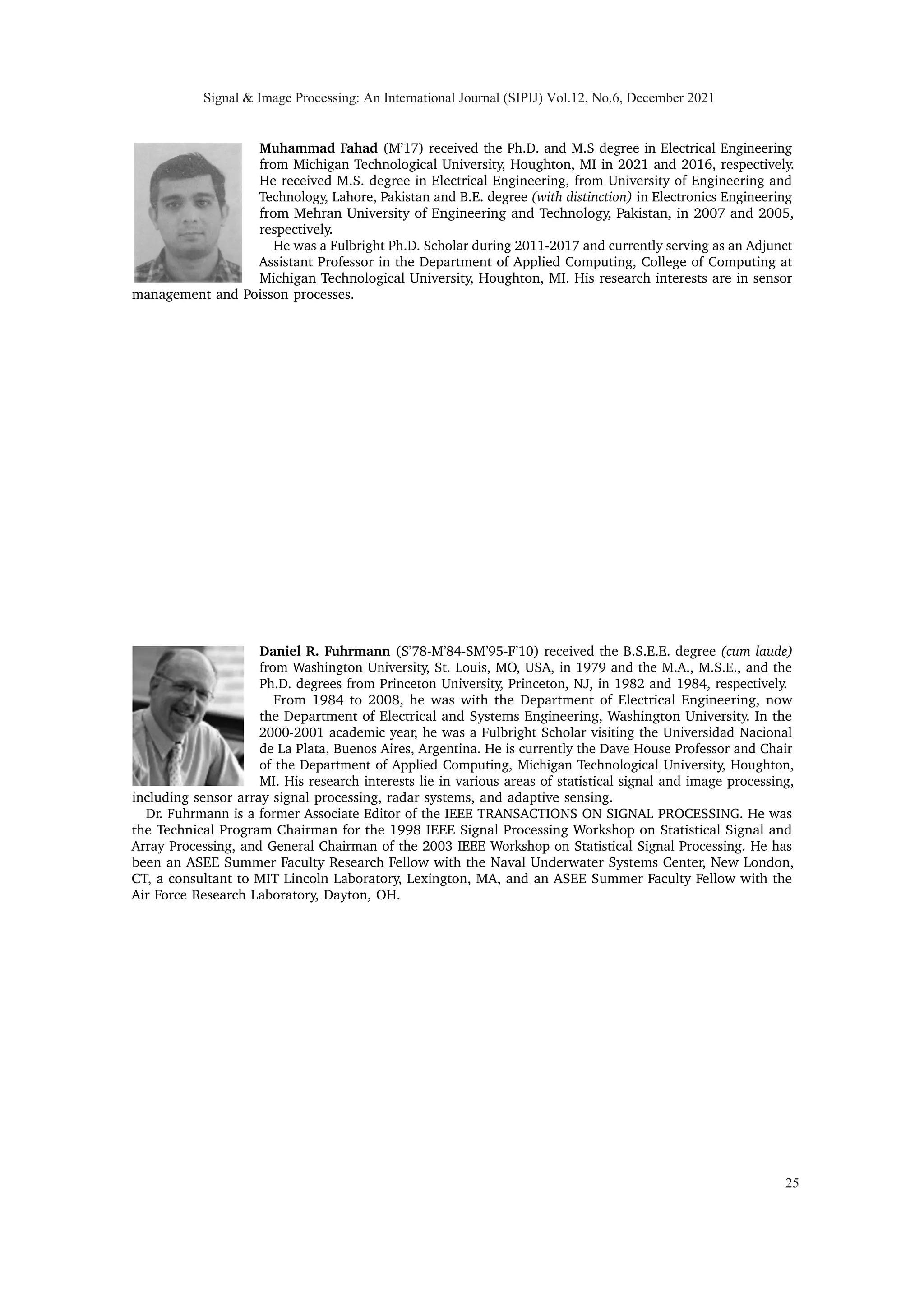This document discusses a sensor scheduling problem for detecting two Poisson sources with known rates using a single counter under time constraints. The authors explore the trade-off between optimizing mutual information and detection probability through individual and joint sensing methods. The results indicate that optimizing these metrics can yield similar yet distinct outcomes, complicating the scheduling strategy in the context of vector Poisson channels.
![Sensing Method for Two-Target
Detection in Time-Constrained Vector
Poisson Channel
Muhammad Fahad, Member, IEEE
Department of Applied Computing
Michigan Technological University
Houghton, MI 49931, USA
mfahad@mtu.edu
Daniel R. Fuhrmann, Fellow, IEEE
Department of Applied Computing
Michigan Technological University
Houghton, MI 49931, USA
fuhrmann@mtu.edu
Abstract
It is an experimental design problem in which there are two Poisson sources with two
possible and known rates, and one counter. Through a switch, the counter can observe
the sources individually or the counts can be combined so that the counter observes the
sum of the two. The sensor scheduling problem is to determine an optimal proportion of
the available time to be allocated toward individual and joint sensing, under a total time
constraint. Two different metrics are used for optimization: mutual information between
the sources and the observed counts, and probability of detection for the associated
source detection problem. Our results, which are primarily computational, indicate
similar but not identical results under the two cost functions.
Index Terms
sensor scheduling, vector Poisson channels.
1. INTRODUCTION
The importance of sensor scheduling emerges when it is not possible to collect
unlimited amounts of data due to resource constraints. [1]. Generally speaking it is
always advantageous to collect as much data as possible, provided such data can be
properly managed and processed. However there are constraints imposed by available time,
computational resources, memory requirements, communication bandwidth, available
battery power, and sensor deployment patterns. This creates a need for an optimal or
heuristic scheduling methodology to extract meaningful data from different available
data sources in an efficient manner.
One of the major challenges in sensor scheduling problems involving switching among
various sources arises from the combinatorial nature of the possible switching possibilities.
This problem becomes further complicated if the sensor scheduling is done in continuous-
time settings [2].
Information-theoretic approaches have long been used in sensor scheduling problems,
especially for their invariance to invertible transformations of the data. Many of the early
approaches towards sensor management were information-theoretic, for instance [3], [4].
Mutual information between observed data and unknown variables under test provides
an intuitively appealing scalar metric for the performance of a given data acquisition
methodology. That being said, it is also well-known that maximizing mutual information
does not necessarily lead to optimal detection or estimation performance.
In this paper we address a very basic problem of scheduling a single sensor with multiple
switch configurations to detect a binary 2-long random vector in a vector Poisson channel.
Signal & Image Processing: An International Journal (SIPIJ) Vol.12, No.6, December 2021
1
DOI: 10.5121/sipij.2021.12601](https://image.slidesharecdn.com/12621sipij01-220112101748/75/Sensing-Method-for-Two-Target-Detection-in-Time-Constrained-Vector-Poisson-Channel-1-2048.jpg)
![Fig. 1: Illustration of sensing method for Bayesian detection of 2−long hidden random
vector X from 3−long observable random vector Y in vector Poisson channel under a
total observation time constraint, where {Pi} is a conditional Poisson point process given
Bernoulli distributed input Xi.
This might be of special interest in context of Poisson compressive sensing, where sparse
signal conditions can be exploited for reduced computational cost and efficient sensor
scheduling. We address this particular sensor scheduling problem from both information
theoretic and detection theoretic perspectives. As will be seen, this problem is deceptively
simple yet does not readily admit closed-form solutions.
The Poisson channel has been traditionally difficult to work with due to two inherent
obstacles attached with it. First, added Poisson noise and scaling of input does not
consolidate into a single parameter as SNR does in Gaussian channel. Second, scaling the
support of a Poisson random variable (integers) does not result in another Poisson random
variable. This is in contrast to Gaussian channels which are relatively well-studied from
both information-theoretic and estimation-theoretic aspects [5], [6], [7]. The Poisson
channel has the advantage in thought experiments such as ours of simple conceptual
models for data acquisition based on counting (photons, say) and switches that either
allow counts to either pass through or be discarded.
As will be seen when our problem is stated in more detail, fundamentally we are
exploring a trade-off between SNR and ambiguity that arises when phenomena from
multiple sources are combined in a single observation. Adding multiple Poisson processes
results in a Poisson process at a higher rate; higher rates correspond to higher SNR, and
generally higher SNR is seen as a good thing for detection and estimation performance.
However, this SNR comes at a cost: with a single detector looking at counts from multiple
processes, the observed Poisson counts cannot be disambiguated back to their original
sources. In our proposed scheme, part of the time is spent looking at sources individually
(to help with this disambiguation) and part of the time is spent observing the sources
jointly (to increase SNR). Finding the right balance between these two approaches is the
Signal & Image Processing: An International Journal (SIPIJ) Vol.12, No.6, December 2021
2](https://image.slidesharecdn.com/12621sipij01-220112101748/75/Sensing-Method-for-Two-Target-Detection-in-Time-Constrained-Vector-Poisson-Channel-2-2048.jpg)
![7/27/2021 sensor_diagram.html
Switch
Source 1
Source 2
Optical Fiber Link
Optical Fiber Link
Photon Counter
Optical Fiber Link
Sensor Scheduling /
Optical Switch
0 1
1 0
1 1
Source
Selected
Source 2 Source 1
Photon Counter
Times
Counts Registered
Switch
Configurations
Vector Poisson Channel
Fig. 2: An abstract example: Y1, Y2 and Y3 are total counts of photons accumulated in
times T1, T2 and T3, respectively. LED source 1 (and source 2) initiates a homogeneous
Poisson process of intensity λ0 if Bernoulli distributed random input signal X1 (and X2)
takes value of 0 with probability (1 − p); and λ1 if input signal X1 (and X2) takes value
of 1 with probability p. Once the input random vector [X0 X1] assumes any of the four
possible states [X0 X1 : 00, 01, 10, 11], it doesn’t change its state during the course of
Photon counting for given time T.
heart of our problem.
In an unconstrained sensing-time setting, the vector Poisson channel has gained much
research activity and interesting results are shown paralleling to that of vector Gaussian
channel. One of the seminal works in linking the information theory and estimation theory
in the context of scalar Poisson channel is done by Guo et al. in [8], where the derivative of
mutual information with respect to signal intensity is equated with a function of conditional
expectation; providing a ground for the possible Poisson counterpart of a Gaussian
channel. This result for scalar Poisson channel was further refined by Atar and Weissman
in [9] where exact relationship between derivative of mutual information and minimum
mean loss error is given by providing the loss function l(x, x̂) = x log(x
x̂ ) − x + x̂ which
shares a key property with squared error loss i-e optimality of conditional expectation
with respect to mean loss criterion. This result together with d
dα I(X; P(αX))](https://image.slidesharecdn.com/12621sipij01-220112101748/75/Sensing-Method-for-Two-Target-Detection-in-Time-Constrained-Vector-Poisson-Channel-3-2048.jpg)
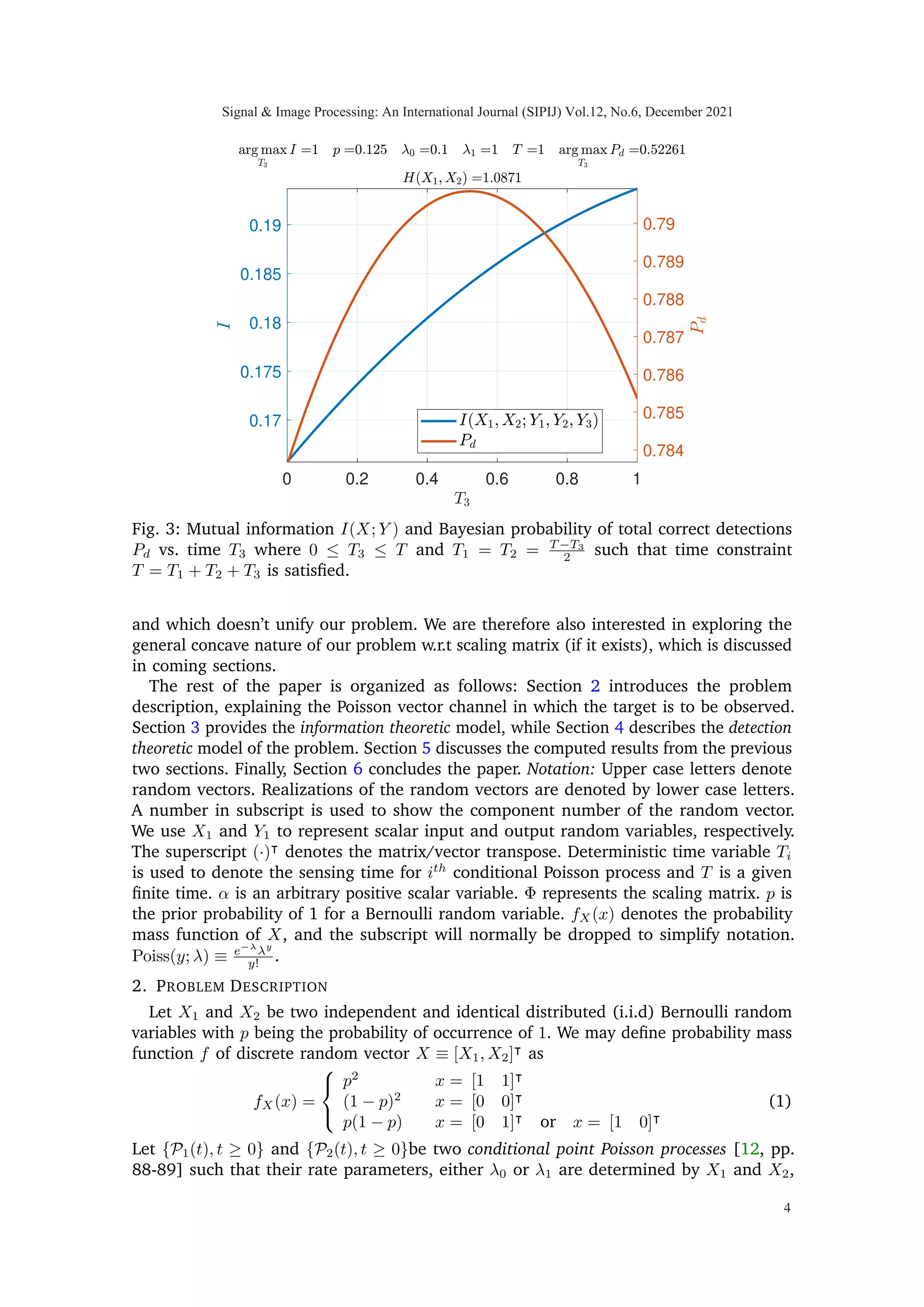
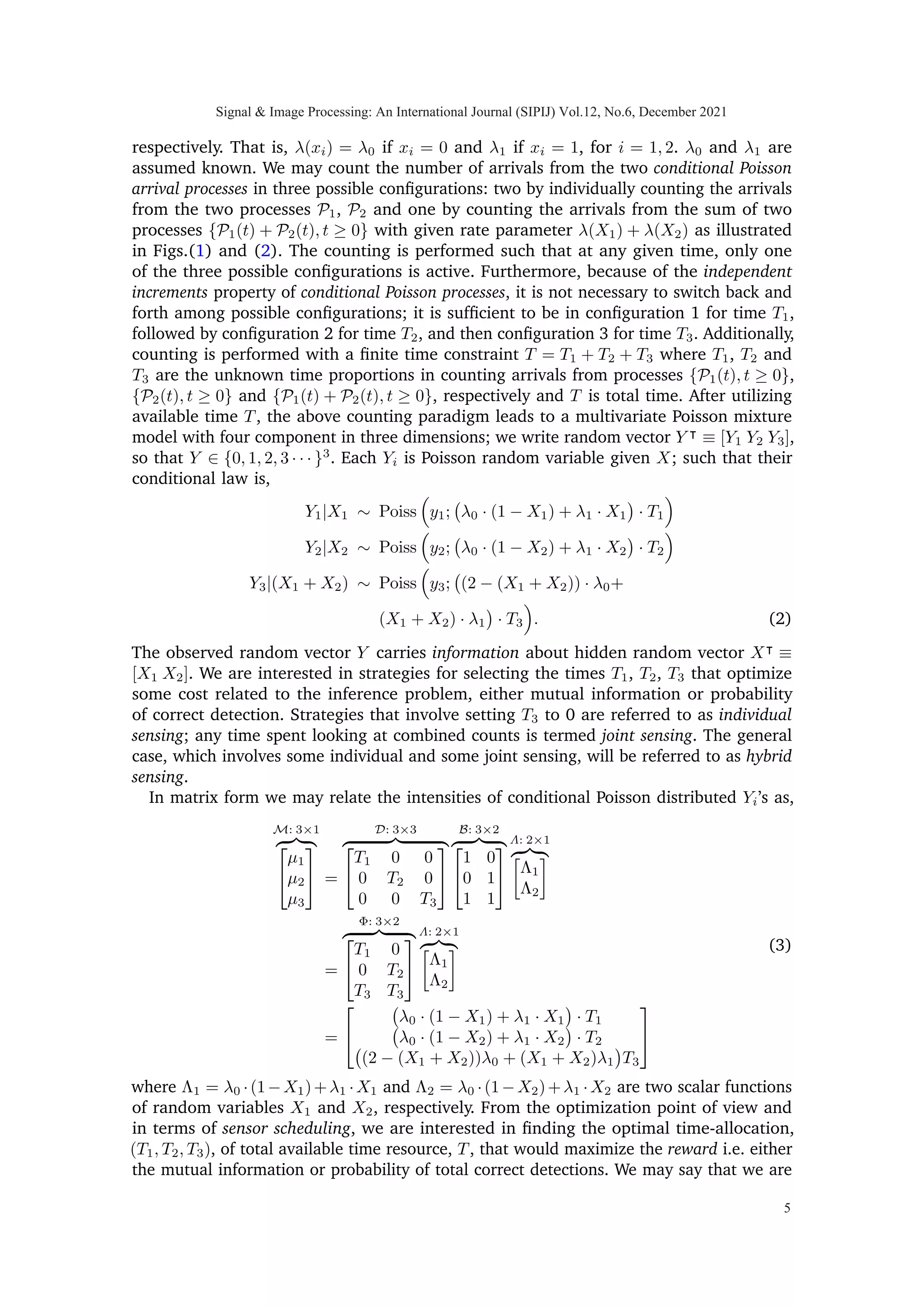
![α=0
=
E[X · log X] − E[X] · log(E[X]) given in [8] provides us an exact answer to the question:
for a given finite sensing time T and prior p, which of the two sensing mechanisms,
individual or joint sensing, is better than the other? (however, hybrid sensing still remains
elusive and this is we have investigated in this paper).
Wang et al. [10] unifies the vector Poisson and Gaussian channels by constructing
a generalization of the classical Bregman divergence and extended the scalar result to
vector case (unconstrained). They provide the gradient of mutual information with respect
to their input scaling matrices for both Poisson and Gaussian channel. But, for a general
vector Poisson channel existence of gradient of mutual information w.r.t scaling matrix
is defined in terms of expected value of the Bregman divergence matrix with a strictly
K-convex loss function and which requires the partial ordering interpretation [11] [10]
Signal & Image Processing: An International Journal (SIPIJ) Vol.12, No.6, December 2021
3](https://image.slidesharecdn.com/12621sipij01-220112101748/75/Sensing-Method-for-Two-Target-Detection-in-Time-Constrained-Vector-Poisson-Channel-6-2048.jpg)
![0 0.2 0.4 0.6 0.8 1
0.17
0.175
0.18
0.185
0.19
0.784
0.785
0.786
0.787
0.788
0.789
0.79
Fig. 3: Mutual information I(X; Y ) and Bayesian probability of total correct detections
Pd vs. time T3 where 0 ≤ T3 ≤ T and T1 = T2 = T −T3
2 such that time constraint
T = T1 + T2 + T3 is satisfied.
and which doesn’t unify our problem. We are therefore also interested in exploring the
general concave nature of our problem w.r.t scaling matrix (if it exists), which is discussed
in coming sections.
The rest of the paper is organized as follows: Section 2 introduces the problem
description, explaining the Poisson vector channel in which the target is to be observed.
Section 3 provides the information theoretic model, while Section 4 describes the detection
theoretic model of the problem. Section 5 discusses the computed results from the previous
two sections. Finally, Section 6 concludes the paper. Notation: Upper case letters denote
random vectors. Realizations of the random vectors are denoted by lower case letters.
A number in subscript is used to show the component number of the random vector.
We use X1 and Y1 to represent scalar input and output random variables, respectively.
The superscript (·)|
denotes the matrix/vector transpose. Deterministic time variable Ti
is used to denote the sensing time for ith
conditional Poisson process and T is a given
finite time. α is an arbitrary positive scalar variable. Φ represents the scaling matrix. p is
the prior probability of 1 for a Bernoulli random variable. fX(x) denotes the probability
mass function of X, and the subscript will normally be dropped to simplify notation.
Poiss(y; λ) ≡ e−λ
λy
y! .
2. PROBLEM DESCRIPTION
Let X1 and X2 be two independent and identical distributed (i.i.d) Bernoulli random
variables with p being the probability of occurrence of 1. We may define probability mass
function f of discrete random vector X ≡ [X1, X2]|
as
fX(x) =
p2
x = [1 1]|
(1 − p)2
x = [0 0]|
p(1 − p) x = [0 1]|
or x = [1 0]|
(1)
Let {P1(t), t ≥ 0} and {P2(t), t ≥ 0}be two conditional point Poisson processes [12, pp.
88-89] such that their rate parameters, either λ0 or λ1 are determined by X1 and X2,
Signal & Image Processing: An International Journal (SIPIJ) Vol.12, No.6, December 2021
4](https://image.slidesharecdn.com/12621sipij01-220112101748/75/Sensing-Method-for-Two-Target-Detection-in-Time-Constrained-Vector-Poisson-Channel-7-2048.jpg)
![respectively. That is, λ(xi) = λ0 if xi = 0 and λ1 if xi = 1, for i = 1, 2. λ0 and λ1 are
assumed known. We may count the number of arrivals from the two conditional Poisson
arrival processes in three possible configurations: two by individually counting the arrivals
from the two processes P1, P2 and one by counting the arrivals from the sum of two
processes {P1(t) + P2(t), t ≥ 0} with given rate parameter λ(X1) + λ(X2) as illustrated
in Figs.(1) and (2). The counting is performed such that at any given time, only one
of the three possible configurations is active. Furthermore, because of the independent
increments property of conditional Poisson processes, it is not necessary to switch back and
forth among possible configurations; it is sufficient to be in configuration 1 for time T1,
followed by configuration 2 for time T2, and then configuration 3 for time T3. Additionally,
counting is performed with a finite time constraint T = T1 + T2 + T3 where T1, T2 and
T3 are the unknown time proportions in counting arrivals from processes {P1(t), t ≥ 0},
{P2(t), t ≥ 0} and {P1(t) + P2(t), t ≥ 0}, respectively and T is total time. After utilizing
available time T, the above counting paradigm leads to a multivariate Poisson mixture
model with four component in three dimensions; we write random vector Y |
≡ [Y1 Y2 Y3],
so that Y ∈ {0, 1, 2, 3 · · · }3
. Each Yi is Poisson random variable given X; such that their
conditional law is,
Y1|X1 ∼ Poiss
y1; λ0 · (1 − X1) + λ1 · X1
· T1
Y2|X2 ∼ Poiss
y2; λ0 · (1 − X2) + λ1 · X2
· T2
Y3|(X1 + X2) ∼ Poiss
y3; (2 − (X1 + X2)) · λ0+
(X1 + X2) · λ1
· T3
. (2)
The observed random vector Y carries information about hidden random vector X|
≡
[X1 X2]. We are interested in strategies for selecting the times T1, T2, T3 that optimize
some cost related to the inference problem, either mutual information or probability
of correct detection. Strategies that involve setting T3 to 0 are referred to as individual
sensing; any time spent looking at combined counts is termed joint sensing. The general
case, which involves some individual and some joint sensing, will be referred to as hybrid
sensing.
In matrix form we may relate the intensities of conditional Poisson distributed Yi’s as,
M: 3×1
z }| {
µ1
µ2
µ3
=
D: 3×3
z }| {
T1 0 0
0 T2 0
0 0 T3
B: 3×2
z }| {
1 0
0 1
1 1
Λ: 2×1
z }| {
Λ1
Λ2
=
Φ: 3×2
z }| {
T1 0
0 T2
T3 T3
Λ: 2×1
z }| {
Λ1
Λ2
=
λ0 · (1 − X1) + λ1 · X1
· T1
λ0 · (1 − X2) + λ1 · X2
· T2
(2 − (X1 + X2))λ0 + (X1 + X2)λ1
T3
(3)
where Λ1 = λ0 ·(1−X1)+λ1 ·X1 and Λ2 = λ0 ·(1−X2)+λ1 ·X2 are two scalar functions
of random variables X1 and X2, respectively. From the optimization point of view and
in terms of sensor scheduling, we are interested in finding the optimal time-allocation,
(T1, T2, T3), of total available time resource, T, that would maximize the reward i.e. either
the mutual information or probability of total correct detections. We may say that we are
Signal Image Processing: An International Journal (SIPIJ) Vol.12, No.6, December 2021
5](https://image.slidesharecdn.com/12621sipij01-220112101748/75/Sensing-Method-for-Two-Target-Detection-in-Time-Constrained-Vector-Poisson-Channel-8-2048.jpg)
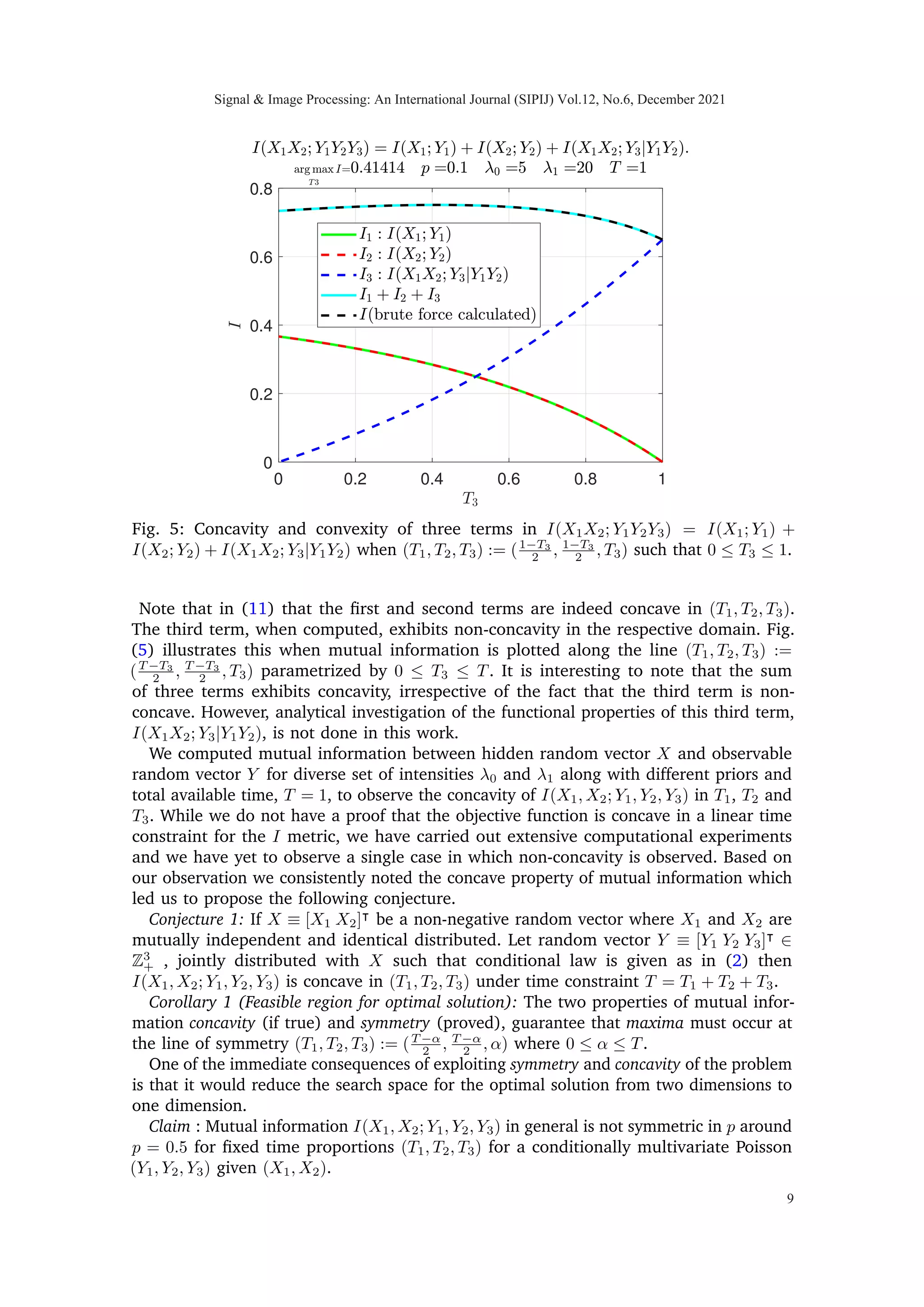
![Bernoulli random variable X1 and Y1 which is a scalar and two component Poisson
mixture. The probability mass function of Y1 is then given as
f(y1) = (1 − p) · Poiss(y1; Tλ0) + p · Poiss(y1; Tλ1).
The mutual information I can be written as
I(X1; Y1) = H(Y1) − H(Y1|X1)
where H(·) is the Shannon entropy, which is defined as a discrete functional H : f →
−
P
Y ∈Y
f · log2(f) and f is the probability mass function of random variate Y with Y as
the corresponding support. We may write H(Y1) as
H(Y1) = −
∞
X
y1=0
[(1 − p) · Poiss(y1; Tλ0) + p
· Poiss(y1; Tλ1)] · log2[(1 − p) · Poiss(y1; Tλ0)
+ p · Poiss(y1; Tλ1)]
,
and
H(Y1|X1) =
X
x1∈X1
f(x1)
∞
X
y1=0
−f(y1|x1) · log2[f(y1|x1)]
= −
(1 − p)
∞
X
y1=0
Poiss(y1; Tλ0)
· log2[Poiss(y1; Tλ0)] + p
∞
X
y1=0
Poiss(y1; Tλ1)
· log2[Poiss(y1; Tλ1)]
.
In Fig. (4), for a scalar Poisson channel discussed above, I(X1; Y1) and Pd illustrates a
monotonic relationship w.r.t T, as expected.
B. Vector Poisson channel
Mutual information between two random vectors can be defined as the difference
between the total entropy in one random vector and the conditional entropy in the second
random vector given the first vector. We write
I(X; Y ) = H(Y ) − H(Y |X) (7)
The conditional entropy H(Y |X) is calculated from the conditional probability mass
functions f(y|X = [x1 x2]|
) defined as
f(y|X = [0 0]|
)
= Poiss(y1; λ0T1) · Poiss(y2; λ0T2) · Poiss(y3; 2λ0T3),
f(y|X = [0 1]|
)
= Poiss(y1; λ0T1) · Poiss(y2; λ1T2) · Poiss(y3; (λ0 + λ1)T3),
f(y|X = [1 0]|
)
= Poiss(y1; λ1T1) · Poiss(y2; λ0T2) · Poiss(y3; (λ1 + λ0)T3),
f(y|X = [1 1]|
)
= Poiss(y1; λ1T1) · Poiss(y2; λ1T2) · Poiss(y3; 2λ1T3).
Signal Image Processing: An International Journal (SIPIJ) Vol.12, No.6, December 2021
7](https://image.slidesharecdn.com/12621sipij01-220112101748/75/Sensing-Method-for-Two-Target-Detection-in-Time-Constrained-Vector-Poisson-Channel-10-2048.jpg)
![The marginal probability mass function of Y is then given as
f(y)
= (1 − p)2
· f(y|X = [0 0]|
) + p(1 − p)·
f(y|X = [0 1]|
) + p(1 − p) · f(y|X = [1 0]|
)+
p2
· f(y|X = [1 1]|
). (8)
Using the identity defined in (7) and the definition of entropy defined above, the mutual
information I(X; Y ) becomes
I(X; Y )
=
∞
X
y1=0
∞
X
y2=0
∞
X
y3=0
−f(y1, y2, y3) · log2[f(y1, y2, y3)])
−
X
X∈X
f(x)
h ∞
X
y1=0
∞
X
y2=0
∞
X
y3=0
−f(y1, y2, y3|X)
· log2[f(y1, y2, y3|X)]
i
. (9)
A complete expression for mutual information is given in Appendix A.
Fig. (3) illustrates the concavity of mutual information as a function of T3 (constrained
problem), in a vector Poisson channel defined in (2) and illustrated in Fig. (1), when
three sensing times are varied according to (T1, T2, T3) = (1−T3
2 , 1−T3
2 , T3) and 0 ≤ T3 ≤ 1.
It can also be seen that the two metrics Pd and I are maximizing at two different input
argument values.
Theorem 1: I(X1, X2; Y1, Y2, Y3) is concave in T3 = 0 plane.
Proof:
I(X1, X2; Y1, Y2, Y3)](https://image.slidesharecdn.com/12621sipij01-220112101748/75/Sensing-Method-for-Two-Target-Detection-in-Time-Constrained-Vector-Poisson-Channel-11-2048.jpg)
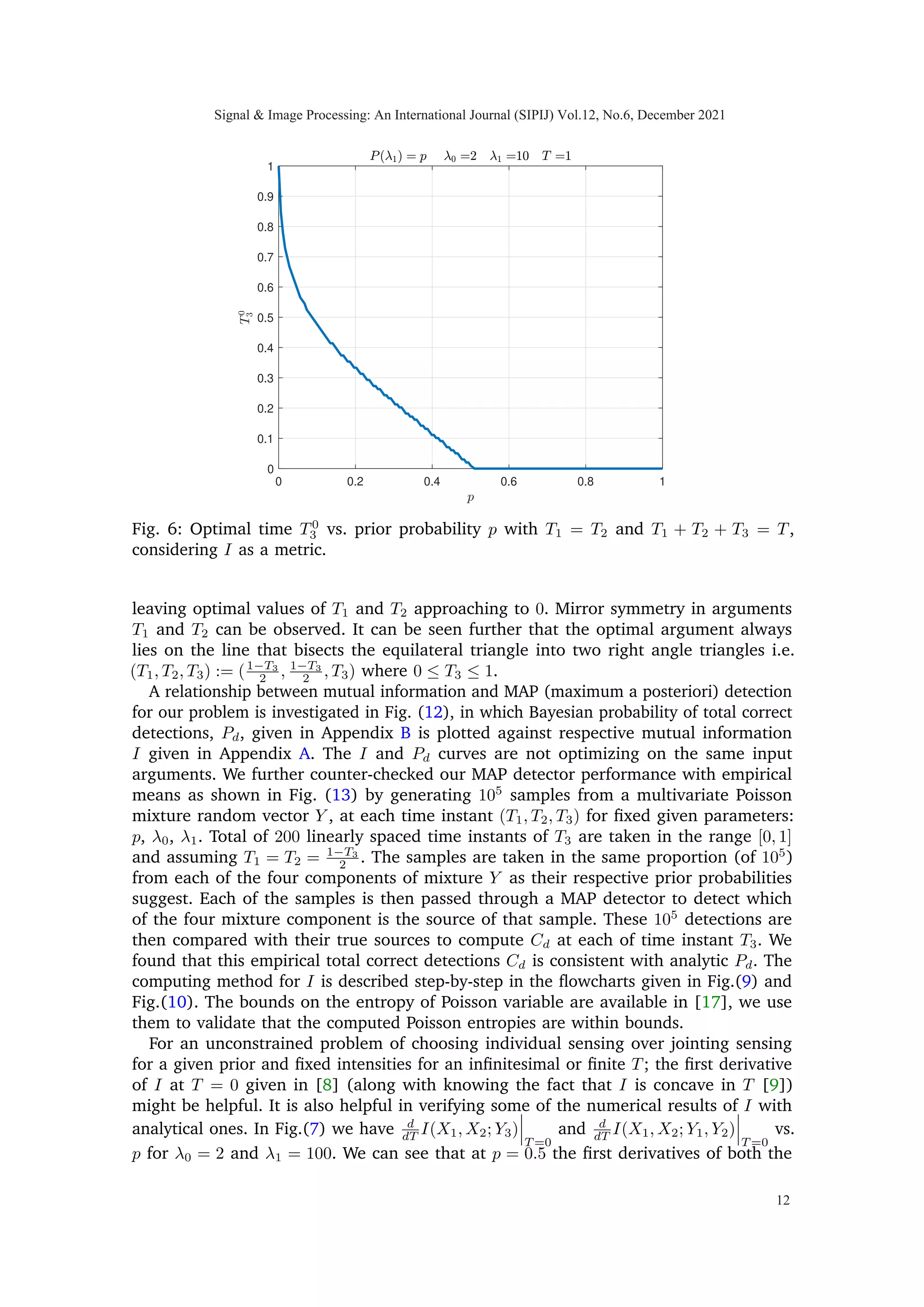
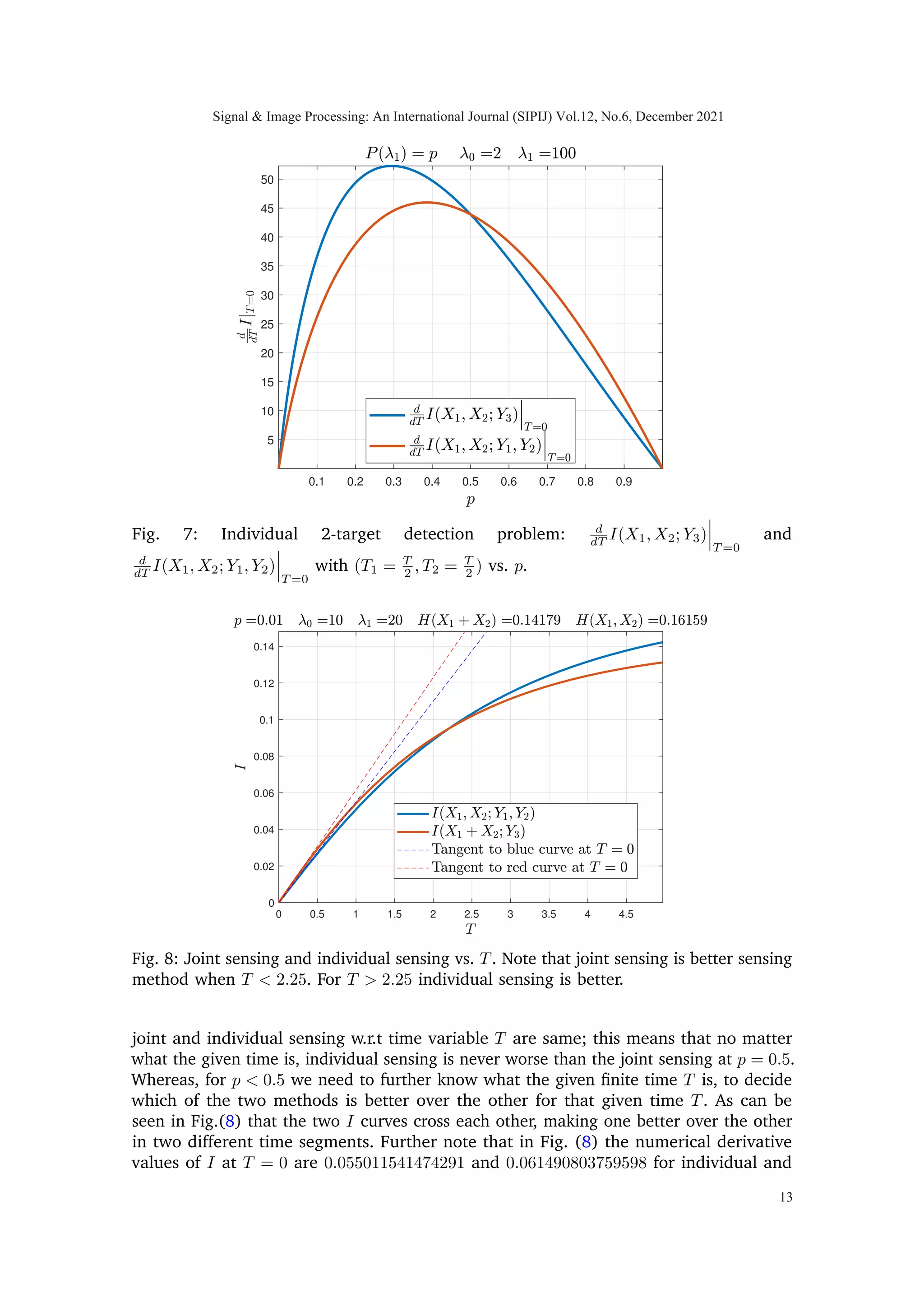
![T3=0
= I(X1, X2; Y1, Y2)
By chain rule of mutual information:
I(X1, X2; Y1, Y2) = I(X1, X2; Y1) + I(X1, X2; Y2|Y1)
=I(X1; Y1) + I(X2; Y2). (10)
We note in (10) that each I(Xi; Yi) is solely a function of Ti and also concave in it [9,
p. 1306][13]. We further know that sum of concave functions is a concave function.
Therefore I(X1, X2; Y1, Y2) is concave in T1 and T2 when T3 = 0. This concludes the
proof.
Theorem 2: I(X1, X2; Y1, Y2, Y3) is symmetric in variables T1 and T2.
Proof: Mutual information I(X1, X2; Y1, Y2, Y3) given in appendix A is invariant under
any permutation of variables T1 and T2. That means interchanging the two variables
leaves the expression unchanged.
If we further expand the expression for mutual information between X and Y using
chain rule [14] [15] as,
I(X1, X2; Y1, Y2, Y3)
= I(X1, X2; Y1) + I(X1, X2; Y2|Y1) + I(X1, X2; Y3|Y1, Y2)
= I(X1; Y1) +
0
z }| {
I(X2; Y1|X1) +
0
z }| {
I(X1; Y2|Y1) +
I(X2;Y2)
z }| {
I(X2; Y2|Y1, X1) +I(X1, X2; Y3|Y1, Y2)
= I(X1; Y1) + I(X2; Y2) + I(X1, X2; Y3|Y1, Y2). (11)
Signal Image Processing: An International Journal (SIPIJ) Vol.12, No.6, December 2021
8](https://image.slidesharecdn.com/12621sipij01-220112101748/75/Sensing-Method-for-Two-Target-Detection-in-Time-Constrained-Vector-Poisson-Channel-14-2048.jpg)
![0 0.2 0.4 0.6 0.8 1
0
0.2
0.4
0.6
0.8
Fig. 5: Concavity and convexity of three terms in I(X1X2; Y1Y2Y3) = I(X1; Y1) +
I(X2; Y2) + I(X1X2; Y3|Y1Y2) when (T1, T2, T3) := (1−T3
2 , 1−T3
2 , T3) such that 0 ≤ T3 ≤ 1.
Note that in (11) that the first and second terms are indeed concave in (T1, T2, T3).
The third term, when computed, exhibits non-concavity in the respective domain. Fig.
(5) illustrates this when mutual information is plotted along the line (T1, T2, T3) :=
(T −T3
2 , T −T3
2 , T3) parametrized by 0 ≤ T3 ≤ T. It is interesting to note that the sum
of three terms exhibits concavity, irrespective of the fact that the third term is non-
concave. However, analytical investigation of the functional properties of this third term,
I(X1X2; Y3|Y1Y2), is not done in this work.
We computed mutual information between hidden random vector X and observable
random vector Y for diverse set of intensities λ0 and λ1 along with different priors and
total available time, T = 1, to observe the concavity of I(X1, X2; Y1, Y2, Y3) in T1, T2 and
T3. While we do not have a proof that the objective function is concave in a linear time
constraint for the I metric, we have carried out extensive computational experiments
and we have yet to observe a single case in which non-concavity is observed. Based on
our observation we consistently noted the concave property of mutual information which
led us to propose the following conjecture.
Conjecture 1: If X ≡ [X1 X2]|
be a non-negative random vector where X1 and X2 are
mutually independent and identical distributed. Let random vector Y ≡ [Y1 Y2 Y3]|
∈
Z3
+ , jointly distributed with X such that conditional law is given as in (2) then
I(X1, X2; Y1, Y2, Y3) is concave in (T1, T2, T3) under time constraint T = T1 + T2 + T3.
Corollary 1 (Feasible region for optimal solution): The two properties of mutual infor-
mation concavity (if true) and symmetry (proved), guarantee that maxima must occur at
the line of symmetry (T1, T2, T3) := (T −α
2 , T −α
2 , α) where 0 ≤ α ≤ T.
One of the immediate consequences of exploiting symmetry and concavity of the problem
is that it would reduce the search space for the optimal solution from two dimensions to
one dimension.
Claim : Mutual information I(X1, X2; Y1, Y2, Y3) in general is not symmetric in p around
p = 0.5 for fixed time proportions (T1, T2, T3) for a conditionally multivariate Poisson
(Y1, Y2, Y3) given (X1, X2).
Signal Image Processing: An International Journal (SIPIJ) Vol.12, No.6, December 2021
9](https://image.slidesharecdn.com/12621sipij01-220112101748/75/Sensing-Method-for-Two-Target-Detection-in-Time-Constrained-Vector-Poisson-Channel-15-2048.jpg)
![Example: For a scalar random variable X1 and conditional Poisson variable Y1 with
scaling factor T, we have equation (115) on page (10) of [8], given below
d
dT
I(X1; Y1)](https://image.slidesharecdn.com/12621sipij01-220112101748/75/Sensing-Method-for-Two-Target-Detection-in-Time-Constrained-Vector-Poisson-Channel-16-2048.jpg)
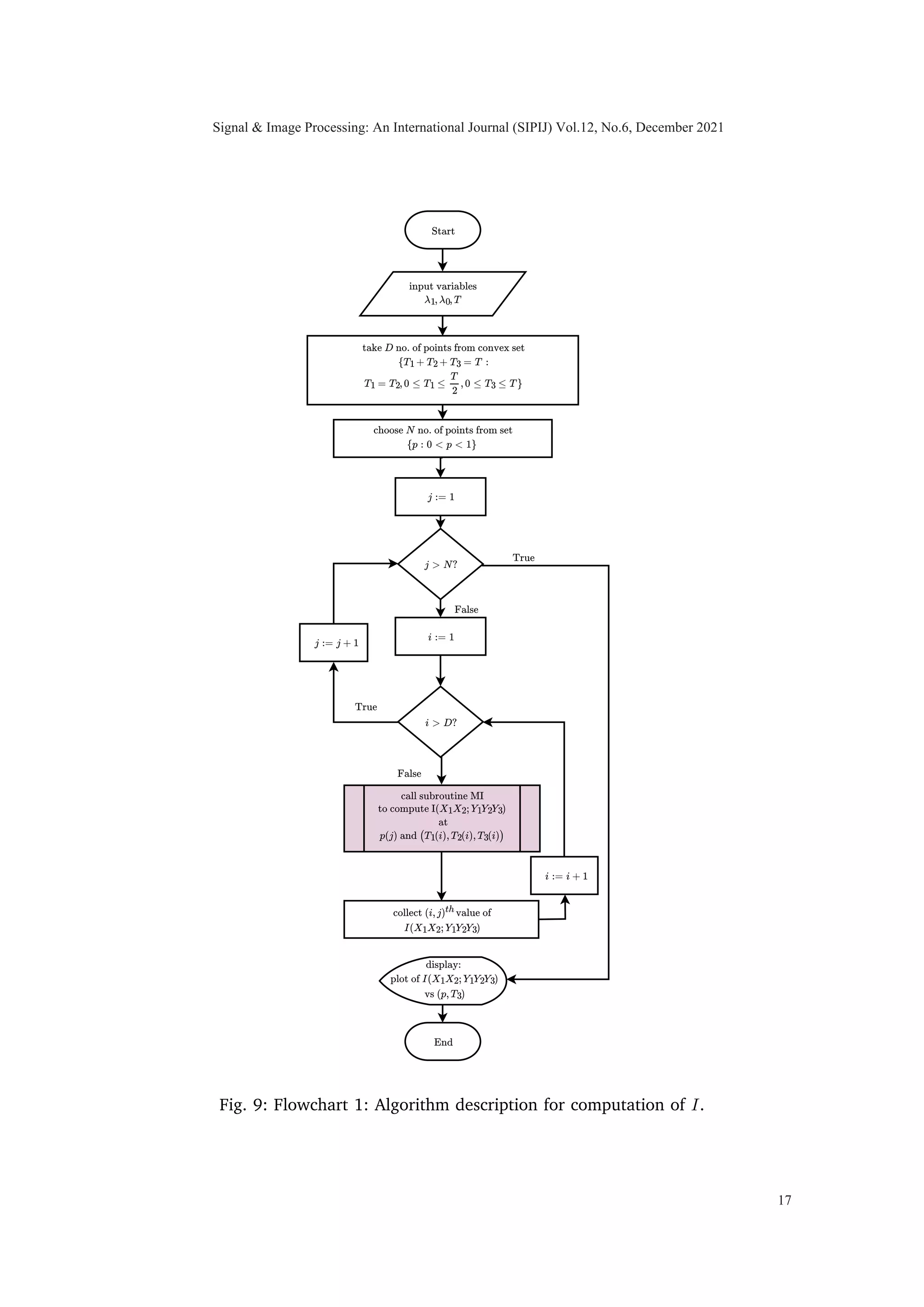

![T =0
= E[Λ1 · log Λ1] − E[Λ1] · log(E[Λ1]).
(12)
where Λ1 = λ0 ·(1−X1)+λ1 ·X1. When we consider a random vector X (instead of scalar
random variable as above), and take distribution on X as given in (1). Dividing variable
total time T equally in counting arrivals from X1 and X2 separately: T1 = T2 = T
2 and
T3 = 0, we have
I(X1, X2; Y1, Y2, Y3)](https://image.slidesharecdn.com/12621sipij01-220112101748/75/Sensing-Method-for-Two-Target-Detection-in-Time-Constrained-Vector-Poisson-Channel-19-2048.jpg)
